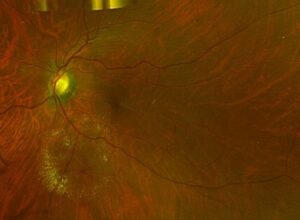Diabetes and Vision: How to Protect Your Eyes
Diabetes is a chronic condition that impacts nearly every part of the body, and one of the most vulnerable areas is eye health. Without proper care, diabetes can lead to severe complications such as diabetic retinopathy, cataracts, and even blindness. However, managing blood sugar levels, scheduling regular eye exams, and making lifestyle adjustments can significantly reduce these risks. This guide covers essential information to protect your vision if you have diabetes, from understanding diabetic retinopathy to making the best dietary choices for eye health.
Understanding Diabetic Retinopathy and Vision Loss

A retinal scan displaying diabetic retinopathy with visible microaneurysms, hemorrhages, and exudates as common signs of diabetes-related eye damage.
One of the most common eye issues for diabetics is diabetic retinopathy—a condition that damages the blood vessels in the retina, leading to vision loss if left untreated. The disease progresses in stages, starting from mild swelling and potentially advancing to severe vision impairment. Early signs of diabetic retinopathy often go unnoticed, making regular eye exams crucial.
Symptoms and Stages of Diabetic Retinopathy
Diabetic retinopathy generally starts without symptoms, but as it progresses, patients may experience blurry vision, dark spots, and difficulty seeing colors. Understanding the stages of diabetic retinopathy can help you and your eye care professional track the condition and take preventive action as early as possible.
-
Mild Nonproliferative Retinopathy: Small areas of swelling in the blood vessels.
-
Moderate Nonproliferative Retinopathy: Blood vessels that nourish the retina become blocked.
-
Severe Nonproliferative Retinopathy: More blood vessels are blocked, depriving areas of the retina of their blood supply.
-
Proliferative Retinopathy: New, abnormal blood vessels grow, which can lead to severe vision problems and even blindness.
Treatment Options for Diabetic Retinopathy
Treatment depends on the severity of the condition. Options include laser treatments to shrink blood vessels, medications injected directly into the eye, and in severe cases, surgery. The best approach is early detection—retinal exams can catch the disease before it progresses.
The Importance of Regular Eye Exams for Diabetics
Regular eye exams are essential for diabetics, as many eye conditions can be detected early, allowing for more effective treatment. Diabetics should undergo eye health checks annually or as recommended by their optometrist. These exams help detect diabetic retinopathy, cataracts, and other complications.
How Diabetes Affects the Retina Over Time
Uncontrolled blood sugar damages the small blood vessels in the retina, leading to diabetic retinopathy. Over time, this can escalate, causing vision loss in diabetes patients. Eye exams can reveal even subtle changes in retinal health, helping to prevent further complications.
Role of Optometrists in Diabetic Eye Care
Your optometrist plays a critical role in managing diabetic eye health. They can guide you on managing blood sugar, selecting the right eye-friendly nutrients, and even recommend retina specialists if needed.
Preventive Measures to Protect Vision with Diabetes
By managing diabetes effectively, you can prevent many eye health issues. Here are some essential preventive measures:
Nutritional Choices for Eye Health in Diabetics
Your diet directly impacts your eye health. Certain foods, rich in antioxidants and vitamins, help protect your vision. Top foods for eye health include leafy greens, carrots, fish rich in omega-3 fatty acids, and nuts. These contain eye-friendly nutrients that help reduce oxidative stress on the retina.
Lifestyle Changes to Reduce Eye Health Risks
Adopting healthy lifestyle choices can significantly benefit your eyes. Regular exercise, managing stress, and avoiding smoking all contribute to healthier blood vessels, reducing the risk of retinopathy. These daily habits for eye health are especially valuable for diabetics.
Controlling Blood Pressure and Cholesterol for Eye Health
Blood sugar management is crucial, but it’s also important to control blood pressure and cholesterol levels. High blood pressure can worsen diabetic eye conditions by increasing pressure on blood vessels in the retina. Simple steps like routine eye screenings, a balanced diet, and regular physical activity can help keep these levels in check.
Frequently Recommended Eye Care Practices
Optometrists often recommend the following eye care regimens for diabetics to ensure optimal eye health:
-
Annual Eye Checkups: Early detection of issues like diabetic retinopathy and cataracts can prevent progression.
-
Glucose Monitoring: Keeping blood sugar levels stable can prevent further damage to the blood vessels in the eyes.
-
Dietary Adjustments: Consuming foods high in vitamins C, E, and beta-carotene can protect the retina and maintain eye health.
Why Diabetic Eye Exams Are Crucial
Diabetic eye exams provide detailed insights into your eye health. Routine screenings help in the early detection of diabetic retinopathy, allowing for timely intervention. If needed, your optometrist may refer you to specialists for diabetic retinopathy for more advanced care.
Conclusion: Take Charge of Your Eye Health with Diabetes
With diabetes, protecting your vision requires proactive steps and regular eye exams. Understanding the effects of diabetes on your retina, managing blood sugar levels, and adopting an eye-healthy lifestyle can make a significant difference. Taking preventive measures and consulting with specialists ensure that you maintain good vision even with diabetes.
By keeping these tips in mind, you can prevent complications and enjoy better long-term eye health.